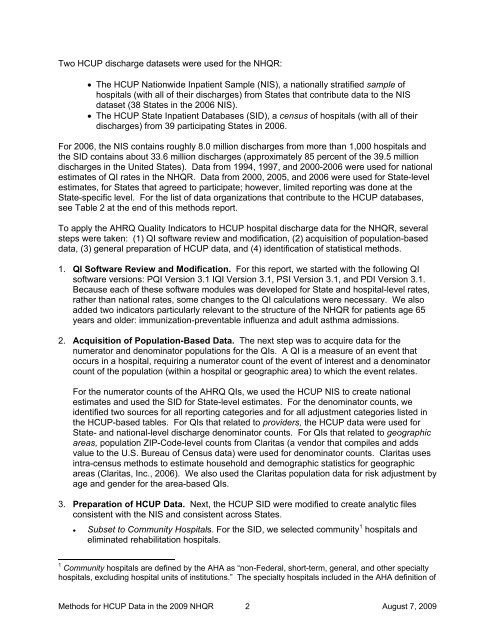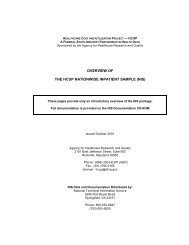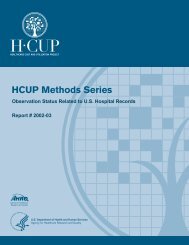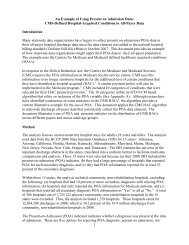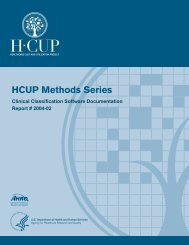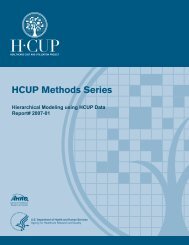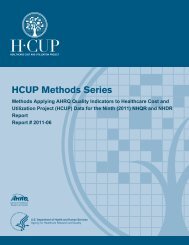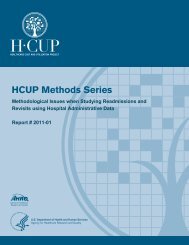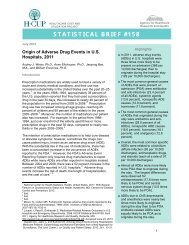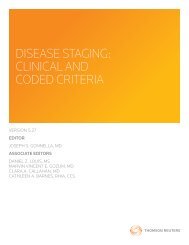Methods Applying AHRQ Quality Indicators to HCUP Data for the ...
Methods Applying AHRQ Quality Indicators to HCUP Data for the ...
Methods Applying AHRQ Quality Indicators to HCUP Data for the ...
You also want an ePaper? Increase the reach of your titles
YUMPU automatically turns print PDFs into web optimized ePapers that Google loves.
Two <strong>HCUP</strong> discharge datasets were used <strong>for</strong> <strong>the</strong> NHQR:• The <strong>HCUP</strong> Nationwide Inpatient Sample (NIS), a nationally stratified sample ofhospitals (with all of <strong>the</strong>ir discharges) from States that contribute data <strong>to</strong> <strong>the</strong> NISdataset (38 States in <strong>the</strong> 2006 NIS).• The <strong>HCUP</strong> State Inpatient <strong>Data</strong>bases (SID), a census of hospitals (with all of <strong>the</strong>irdischarges) from 39 participating States in 2006.For 2006, <strong>the</strong> NIS contains roughly 8.0 million discharges from more than 1,000 hospitals and<strong>the</strong> SID contains about 33.6 million discharges (approximately 85 percent of <strong>the</strong> 39.5 milliondischarges in <strong>the</strong> United States). <strong>Data</strong> from 1994, 1997, and 2000-2006 were used <strong>for</strong> nationalestimates of QI rates in <strong>the</strong> NHQR. <strong>Data</strong> from 2000, 2005, and 2006 were used <strong>for</strong> State-levelestimates, <strong>for</strong> States that agreed <strong>to</strong> participate; however, limited reporting was done at <strong>the</strong>State-specific level. For <strong>the</strong> list of data organizations that contribute <strong>to</strong> <strong>the</strong> <strong>HCUP</strong> databases,see Table 2 at <strong>the</strong> end of this methods report.To apply <strong>the</strong> <strong>AHRQ</strong> <strong>Quality</strong> <strong>Indica<strong>to</strong>rs</strong> <strong>to</strong> <strong>HCUP</strong> hospital discharge data <strong>for</strong> <strong>the</strong> NHQR, severalsteps were taken: (1) QI software review and modification, (2) acquisition of population-baseddata, (3) general preparation of <strong>HCUP</strong> data, and (4) identification of statistical methods.1. QI Software Review and Modification. For this report, we started with <strong>the</strong> following QIsoftware versions: PQI Version 3.1 IQI Version 3.1, PSI Version 3.1, and PDI Version 3.1.Because each of <strong>the</strong>se software modules was developed <strong>for</strong> State and hospital-level rates,ra<strong>the</strong>r than national rates, some changes <strong>to</strong> <strong>the</strong> QI calculations were necessary. We alsoadded two indica<strong>to</strong>rs particularly relevant <strong>to</strong> <strong>the</strong> structure of <strong>the</strong> NHQR <strong>for</strong> patients age 65years and older: immunization-preventable influenza and adult asthma admissions.2. Acquisition of Population-Based <strong>Data</strong>. The next step was <strong>to</strong> acquire data <strong>for</strong> <strong>the</strong>numera<strong>to</strong>r and denomina<strong>to</strong>r populations <strong>for</strong> <strong>the</strong> QIs. A QI is a measure of an event tha<strong>to</strong>ccurs in a hospital, requiring a numera<strong>to</strong>r count of <strong>the</strong> event of interest and a denomina<strong>to</strong>rcount of <strong>the</strong> population (within a hospital or geographic area) <strong>to</strong> which <strong>the</strong> event relates.For <strong>the</strong> numera<strong>to</strong>r counts of <strong>the</strong> <strong>AHRQ</strong> QIs, we used <strong>the</strong> <strong>HCUP</strong> NIS <strong>to</strong> create nationalestimates and used <strong>the</strong> SID <strong>for</strong> State-level estimates. For <strong>the</strong> denomina<strong>to</strong>r counts, weidentified two sources <strong>for</strong> all reporting categories and <strong>for</strong> all adjustment categories listed in<strong>the</strong> <strong>HCUP</strong>-based tables. For QIs that related <strong>to</strong> providers, <strong>the</strong> <strong>HCUP</strong> data were used <strong>for</strong>State- and national-level discharge denomina<strong>to</strong>r counts. For QIs that related <strong>to</strong> geographicareas, population ZIP-Code-level counts from Claritas (a vendor that compiles and addsvalue <strong>to</strong> <strong>the</strong> U.S. Bureau of Census data) were used <strong>for</strong> denomina<strong>to</strong>r counts. Claritas usesintra-census methods <strong>to</strong> estimate household and demographic statistics <strong>for</strong> geographicareas (Claritas, Inc., 2006). We also used <strong>the</strong> Claritas population data <strong>for</strong> risk adjustment byage and gender <strong>for</strong> <strong>the</strong> area-based QIs.3. Preparation of <strong>HCUP</strong> <strong>Data</strong>. Next, <strong>the</strong> <strong>HCUP</strong> SID were modified <strong>to</strong> create analytic filesconsistent with <strong>the</strong> NIS and consistent across States.• Subset <strong>to</strong> Community Hospitals. For <strong>the</strong> SID, we selected community 1 hospitals andeliminated rehabilitation hospitals.1 Community hospitals are defined by <strong>the</strong> AHA as “non-Federal, short-term, general, and o<strong>the</strong>r specialtyhospitals, excluding hospital units of institutions.” The specialty hospitals included in <strong>the</strong> AHA definition of<strong>Methods</strong> <strong>for</strong> <strong>HCUP</strong> <strong>Data</strong> in <strong>the</strong> 2009 NHQR 2August 7, 2009


